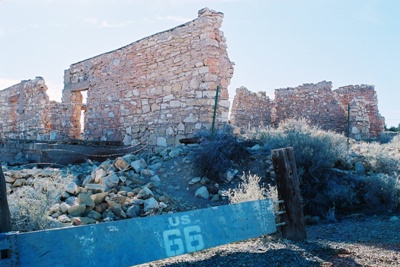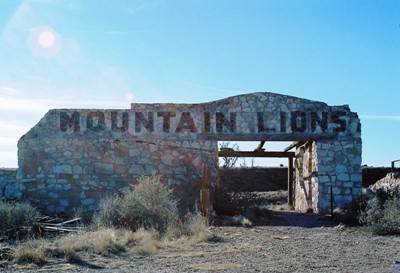
NOVEMBER 2022 UPDATE: This post was written just over a decade ago, and a couple years back I posted an introductory caveat about the veracity of the Apache Death Cave story. A comment below by "Kirvia" noted the lack of primary material for the tale, and he had an excellent point. Henry "Indian" Miller had emerged as seemingly the most obvious source, and he appeared to be far from a reliable narrator. After leaving Two Guns, Miller went to Lupton, Arizona, and opened a trading post he named the "Cave of the Seven Devils." Sound familiar? It didn't inspire confidence in Miller's version of history.
Well, fast forward a bit and I find myself at the excellent RECYCLED BOOKS*RECORDS*CDs in Denton, Texas. While digging through their Southwest section I uncover a slim volume published in 1968 entitled, "The Press of the Territorian Presents Number 15 of a Series of Western Americana: Two Guns, Arizona," by Gladwell Richardson, whose father, S.I. Richardson, bought Wolf Post in Canyon Diablo in 1899. S.I. is stated within to have known all the local Native Americans and settlers of the time. Color me surprised.
What you'll find contained in those 28 pages, along with numerous photos, is a recounting of the story of the Apache Death Cave virtually identical to what's generally been told, as well as the name of a Navajo man said to have been involved, Hosteen Natani ("hosteen" is a Navajo term of respect), who is also noted as having provided a personal statement at one point. Richardson compiled a pretty impressive summary of the supposed history of Canyon Diablo and Two Guns Trading Post, which was still operating at the time of publication, and it makes me think that maybe the trail backward doesn't end with Miller.
Of course, I'd love to track the story back even futher, and there are some earlier references. They include:
Correl, J. Lee and Watson, Editha L. 1967. A Navajo Bibliography. The Navajo Tribe. Window Rock, AZ.
Kildare, Maurice. 1967. Cave of Death Desert Magazine.
Sumerhayes, Martha. 1911. Vanished Arizona. The Salem Press Co. Salem, MA.
There are a number of others, and I'll be keeping an eye open for them and will post anyting more I can learn here. But, for now, I can say that virtually everything below aligns with Mr. Richardson's work, even beyond the gruesome story of the Apache Death Cave. That said, there are some things in his book that I might question, including Billy the Kid's appearance at Canyon Diablo, the size and lawlessness of the Canyon Diablo railroad camp itself, and a loner roaming the area and hoarding a fortune in diamonds found in meteorites. But whatever the case, you can read below and see what you think for yourself. And stand by for (hopefully) further updates.
Anyone that’s interested in abandoned buildings, ghost towns, and history is going to find themselves in some places where fairly unsavory things have occurred. Sometimes there’s just a bad vibe that surrounds a place even when you don’t know exactly what’s happened there. Other times maybe you’ve cracked a few books or done a Google search beforehand and you know where those bad vibes are coming from. Such is the case with Two Guns, Arizona, now not much more than a slowly decaying jumble of collapsed stone buildings off a long-closed portion of old Route 66.
Two Guns miserable history goes back to a time well before it was known as Two Guns. The town, such as it became, was built beside Canyon Diablo, the site of a mass execution of Apaches by Navajos in 1878. The Apaches had been raiding the Navajos for some time and had just nearly wiped out two entire villages in one day. Twenty-five Navajo warriors followed the Apaches back to Canyon Diablo but had nearly given up their search when two scouts detected warm air coming out of a crack in the ground.
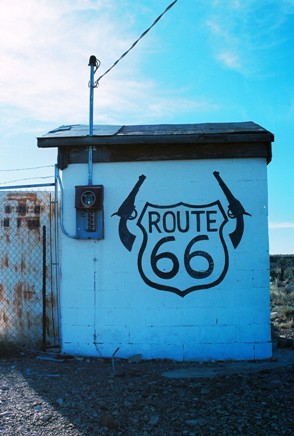 Below this crack was a large cave where over 40 Apaches were hiding with their horses. Two Apaches, oblivious to the Navajos, stepped into the open and were quickly killed. Then the Navajos lit a fire at the mouth of the cave with brush and driftwood from the canyon floor. The Apaches tried to negotiate, but when the Navajos asked for the return of three small girls that had been taken hostage they were met with silence. Understanding that the girls had been killed, the Navajos piled on more fuel and eventually every Apache was either asphyxiated or burned alive. It took a full day for the walls of the cave to cool enough for the Navajos to enter to re-claim their stolen belongings. Inside they saw that the Apaches had tried to use the blood of their horses to douse the flames. The Navajo warned anyone who asked to stay away and consider the entire area cursed to this day.
Below this crack was a large cave where over 40 Apaches were hiding with their horses. Two Apaches, oblivious to the Navajos, stepped into the open and were quickly killed. Then the Navajos lit a fire at the mouth of the cave with brush and driftwood from the canyon floor. The Apaches tried to negotiate, but when the Navajos asked for the return of three small girls that had been taken hostage they were met with silence. Understanding that the girls had been killed, the Navajos piled on more fuel and eventually every Apache was either asphyxiated or burned alive. It took a full day for the walls of the cave to cool enough for the Navajos to enter to re-claim their stolen belongings. Inside they saw that the Apaches had tried to use the blood of their horses to douse the flames. The Navajo warned anyone who asked to stay away and consider the entire area cursed to this day. A few decades later a shortcut to Winslow was built through Canyon Diablo. (As an aside, if you’re not up on your Spanish, Canyon Diablo translates as “Devil Canyon.”) In the 1920’s, Earle and Louise Cundiff opened a trading post, campground, and rental cottages near the road, just beside the canyon. The main store was constructed at the southern end of what would soon be a large, concrete bridge spanning Canyon Diablo. Then a man called Henry “Indian” Miller came along, claiming to be an Apache chief named Crazy Thunder. Miller was no Apache (he was really part-Mohawk), but he and his wife partnered up with the Cundiff’s and Miller constructed a long stone building north of the canyon that he named, “Fort Two Guns.” Cundiff then wanted to proclaim this miniature community a town and dub the whole place Two Guns. However, the post office rejected this name, insisting instead on Canyon Lodge, a moniker that has nearly faded from memory.
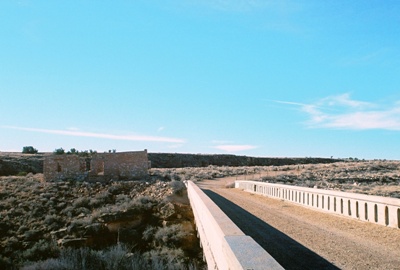
Miller went about turning Fort Two Guns into something like a zoo, including bobcats, snakes, porcupines, and mountain lions. He also built fake cliff dwellings, which he passed off as authentic, just above the cave in which the Apaches had been killed. The cave was called “Mystery Cave” because the Navajos had been unable to find it following earlier raids by the Apaches. It was also known as the "Apache Death Cave,” and Miller lured motorists off Route 66 with canyon tours, refreshments, and tales of carnage. He sold the bones of the dead Apaches to tourists. For awhile, Two Guns prospered.
While all this was going on, for some reason the Cundiff’s decided to lease their store to a drifting couple. These drifters eventually absconded into the night with most of the Cundiff’s merchandise. Then, Cundiff began to argue with Miller over the terms of their contract. On March 3, 1926, Miller shot Cundiff dead and was, for reasons unknown, quickly acquitted. But Miller wasn’t off the hook. Upon returning to Two Guns he was nearly killed by his captive mountain lion. Later he was nearly killed by his lynx. After his daughter was killed in a car crash, Miller had finally had enough and left Two Guns for good.
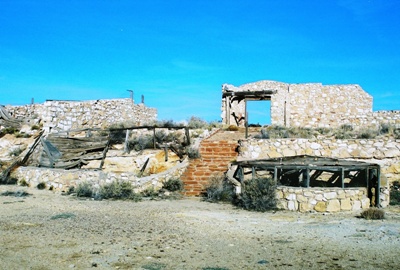
In 1938, Route 66 was rerouted to the south, bypassing Two Guns. But Louise Cundiff re-married and, with her second husband, rebuilt Two Guns, even re-opening Miller’s zoo. But the renewal didn’t last long. By 1950 everything was closed again and the property was sold. Several people tried to resurrect Two Guns but, in 1971, just as I-40 was slated to open with a designated exit for the "town," the entire complex burnt down. And so it has remained for 40 years, a strange, cursed place that nobody wants. Except perhaps for Russell Crowe, who is rumored to be the property’s current owner.
I didn’t have much time during my visit and I did not go looking for the Apache Death Cave. The cave has apparently largely collapsed and is no more than a fissure in a rock wall. Nor did I go looking for meteorites, bits of which have been pulled out of the canyon, a nice treasure indeed for the lucky prospector. I didn’t even have time to search for the remains of the town of Diablo Canyon, just a couple miles from Two Guns, which was forced into being when the railroad ran out of money for a time and workers were stranded. Diablo Canyon was said to have surpassed Tombstone for murder and debauchery. Its main street was not named “Main Street” but “Hell Street.”
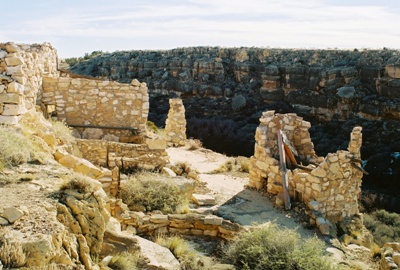
I may make a return trip to Two Guns someday but I admit that I am wary. It seems no one who has gotten close to Two Guns has fared well in the end. It is a quiet, eerie, forlorn place, strewn with the rocks that the Miller's and Cundiff’s once used to build their dream. Maybe I’d be better off investigating the abandoned truck stop to the west. Its name? Twin Arrows.
Information for this post came from Weird Arizona by Wesley Treat. The best source for information on the execution of the Apaches is probably Treat’s on-line Roadside Resort. I got some information about the settlement of Canyon Diablo from Wikipedia.
